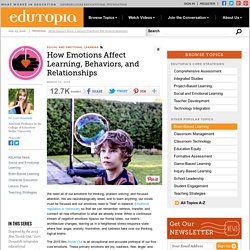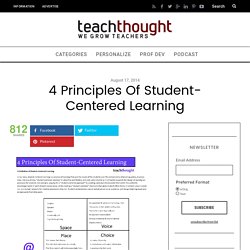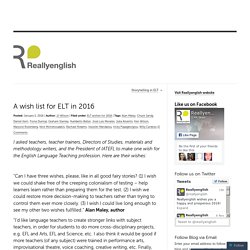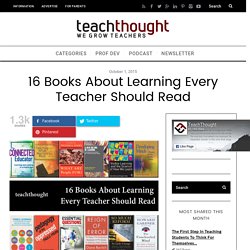

Eight Tips for Fostering Flow in the Classroom. Worldly Winds. How Emotions Affect Learning, Behaviors, and Relationships. We need all of our emotions for thinking, problem solving, and focused attention.

We are neurobiologically wired, and to learn anything, our minds must be focused and our emotions need to "feel" in balance. Emotional regulation is necessary so that we can remember, retrieve, transfer, and connect all new information to what we already know. When a continuous stream of negative emotions hijacks our frontal lobes, our brain's architecture changes, leaving us in a heightened stress-response state where fear, anger, anxiety, frustration, and sadness take over our thinking, logical brains. Neuroplasticity/Feelings. All Things Linguistic. Richer Speaking. Eight Tips for Fostering Flow in the Classroom. Beware of nominalizations (AKA zombie nouns) - Helen Sword.
Lesson idea: Star Wars crawl creator. Security Check Required. Rhythm helps your two lips move. 4 Principles Of Student-Centered Learning. 4 Principles Of Student-Centered Learning by TeachThought Staff A Definition of Student-Centered Learning.

How Improv Can Open Up the Mind to Learning in the Classroom and Beyond. Long before Amy Poehler became famous for her comic roles as Hillary Clinton on “Saturday Night Live,” and as indefatigable bureaucrat Leslie Knope on “Parks and Recreation,” she was a college freshman looking for something to do outside class.

During her first week on campus, she auditioned for the school’s improvisational theater group, “My Mother’s Fleabag,” and discovered a passion. “Everyone was getting to act and be funny and write and direct and edit all at the same time,” she writes in her memoir, Yes, Please. Great for educators, fair for authors. Moral Dilemmas. Process writing: mixing it up. As the name suggests, process writing is an approach to writing which focuses on the process rather than the end product.

The argument goes that, just as writers in the ‘real’ world go through a process of editing and revising what they write, so should our students. The typical structure for a process writing lesson might be: 1 Brainstorming ideas. 2 Plan the structure of the writing 3 Write first draft 4 Get feedback on first draft from teacher or peers (or self-evaluation) 5 Write second draft (and third if appropriate after feedback) Krashen’s theories of language aqusition- do they still have value in the ELT classroom? Robert William McCaul and Marek Kiczkowiak debate the merits of Krashen’s theories on second language acquisition.

Can second languages be learned in the same way in which young children pick up their first language? ALC Newsletter - December 2015. There is no better way of learning about a country than through its culture; I did just that with my pupils, and they loved it.

We did a cultural project that lasted a whole month, with a different English-speaking country presented each week. The United Kingdom (UK; to include Great Britain and Northern Ireland), the United States of America (USA), Australia, and Canada were our destinations. Each of the countries were assigned a guide: The UK was guided by Roberta Vucinic, dressed like Hermione Granger from the Harry Potter book series; the USA was guided by Valentina Alincic—or the best Minnie Mouse on this side of the pond; the Australian guide was Vanja Vucinic, or a famous cartoon character Felix the Cat; while Canada was presented by Mirjam Golik, or our own Atomic Betty. Go Green in Your Classroom: 16 Resources for Environmental Lessons.
Take a walk through the woods or spend an evening soaking up the sight of the night sky.

Planet Earth is chock full of gorgeous things, but the functionality of the planet depends on complex ecosystems that are suffering because of mankind’s abuse. How can you help your students love the environment and inspire them to contribute to building a sustainable, clean future for the planet? The following resources may fit the bill. Resource Compilations and Lesson Plans to Get You Started. Challenges and Changes – Are You Ready? – iTDi Blog. University Life. My (little) reflective journey today. For me, the end of a calendar year and the beginning of the next comes a distant second to the beginning and ends of academic years in opportunity for reflection and goal-setting.

I may be in the minority that way, but a different type of reflection organically comes then: one of classroom-based pedagogy. Having said this, with some lovely time off from work, I intend to do some broader humanistic reflection and goal-setting also, the first foray of which has transformed into a little experiment I’m going to do as I write. To begin, over the past week I read a few reflections on 2015 from the PLN, various reflective practice texts, and boards of education. I collated probably around 25 questions that piqued my interest, but ultimately remixed, mashed-up, and pared these down to 4 that arguably elicit perspective from four corners of my professional life. What do I consider to be my most important professional accomplishment? Here’s the reflective journey to be taken…
A wish list for ELT in 2016. I asked teachers, teacher trainers, Directors of Studies, materials and methodology writers, and the President of IATEFL to make one wish for the English Language Teaching profession.

16 Books About Learning Every Teacher Should Read. 16 Books About Learning Every Teacher Should Read by TeachThought Staff Ed note: This post has been updated from a 2013 post.

How To Prepare Students For 21st Century Survival. 7 Skills Students Will Always Need by Jennifer Rita Nichols Ed note: This post has been updated from a 2013 post. 8 Characteristics Of A Great Teacher. 8 Characteristics Of A Great Teacher by Ian Lancaster What makes a teacher strong? Sir Ken Robinson: Creativity Is In Everything, Especially Teaching. 10 Examples & Non-Examples Of Differentiated Instruction - What Is Differentiated Instruction? How to Give Your Students Better Feedback in Less Time. Online instructors focus most of their teaching on curricular issues—what they will teach, how they will teach it, etc. But studies have found that differences in curriculum have little, if any, effect on student outcomes.
John Hattie compared more than 100 factors related to student achievement from more than 180,000 studies and ranked the factors from most significant to least significant. 5 Questions on the Nitty Gritty of Tech Integration :Educational Strategies. Last week, we hosted a webinar at Education Week on effective integration of technology in the classroom. Learning with 'e's: Why schools shouldn't ban smartphones. Using Old Tech (Not Edtech) to Teach Thinking Skills. I've been trying to use Google Docs to good effect in my ninth grade history classroom. The 5 Best Times to Use Technology in Class. The 37 Best Websites To Learn Something New. Forget overpriced schools, long days in a crowded classroom, and pitifully poor results. The box (Videotelling) The box (Videotelling) 5 Infographics to Teach You How to Easily Make Infographics in PowerPoint [Free Templates] Luke Meddings. CELTA and Technology – With or Without it?
Educational Media and Technology. ISTE. Untitled. Mental Health and ELT. Reflections on Innovate ELT.